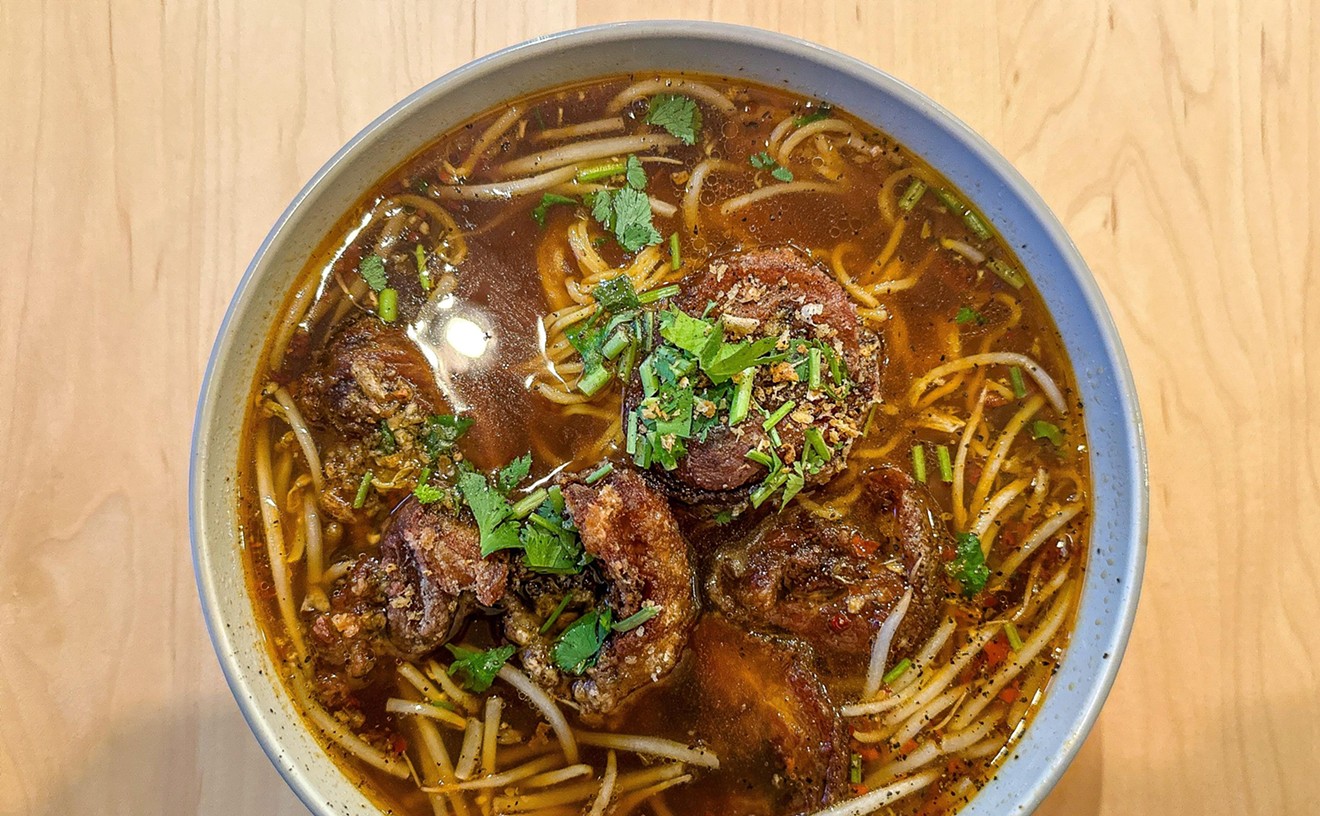Ethiopian food isn't eaten with utensils. It's pinched with torn thin sheets of fermented foam-rubber-like unleavened bread called injera. It's a retrieval process rather like what a considerate dog owner might engage in with a plastic bag during pooch walks. Everything--salads, stewed meats, vegetables--is pinched in folds of injera and fingered into the mouth. The injera at the new Ethiopian restaurant Ghion (the word means "heavenly river," the name for the Nile in Amharic, the official Ethiopian language) is deep brown, and the sour aroma is profuse--not as clean as other injera examples. But no matter the scents, the bread doesn't obviate the need for napkins. I accumulated little piles of stained paper balls at my place setting.
On the walls of Ghion, amongst the tourism posters boasting of Ethiopia's yearlong sunshine, are little bundles of grain. These are the varieties--barley, corn, millet, and an Ethiopian variety called teff--from which the tangy injera emerges.
The other famous Ethiopian fermentation is tej, a wine made from water, honey, and millet. At one time there were no desserts in Ethiopia because of a lack of sweeteners. Honey, the only sweetener available, was funneled into the making of tej, a sweet drink that smells and tastes remotely like a late-harvest dessert wine poured over a bowl of gerbil food. And at Ghion this is the preferred drink, because the other wine list entries are little 187-milliliter bottles of Sutter Home this and that, which is confusing. After ordering a red wine to wash down the spaghetti with meat sauce ($6.99) I planned to pilfer from the 5-year-old at our table (the sauce was rich, but the ground meat was rubbery), I was presented with a little bottle of white zinfandel. Not that I have anything against a wine that looks as if it were made by Peter Max, but if I'm going to go suckle sweet, I'll slurp what the natives sip. Yet Ghion's tej was perplexing. On one visit it was golden brown with a bouquet of freshly filled birdfeeder mingled with a Tupperware burp of turning fruit salad. On the second visit, the sip had that same birdfeeder-fruit-salad-bred bouquet, only this time the fluid was darker, with peaish green hues, and effervescent. This was either funky winemaking or funky storage.
At the start of the meal, a generous platter of injera is delivered, which in retrospect should have been spread over my lap. Listed on Ghion's menu is a variety of meat dishes. But there is also a bone toss to the meat-phobic. Vegetarian delight ($8.99) is a collection of a half-dozen vegetable dishes.
Perhaps in a fit of sacrilege, we mixed these little dishes with an order of quanta firfir ($8), spicy jerked beef slathered in wot (a sauce made from butter and spices) sown through small scraps of injera. Like knots of seasoned bootstrap, the jerky was hard and chewy, peeking through red-sauced injera folds like dark, dull corneas. The quanta firfir was planted in the center of the platter, perhaps to suffer the ridicule of the vegetable dishes surrounding it. A dark green clot of gomen, chopped collard greens sautéed with onion and garlic, was a bit mushy and overcooked. But the Ethiopian salad, with flecks of tomato, onion, and jalapeño, with chopped injera washed in lemon, was brisk and supple, more so than you'd expect from an unleavened bread drenched in dressing. There was also a straight-ahead garden salad of little note and a little yemiser wot, split lentils in red pepper sauce. Rounding things off was yataklete alitcha, a sauté of potato, carrot, and cabbage seasoned with garlic juice.
"Ghion is the brainchild of Amaki," says the Ghion press release, "an expatriate Ethiopian with a love for preparing both traditional (lamb, beef, chicken) and meatless Ethiopian and Ethiopian-Italian dishes." I called Amaki, not only to sort out her new restaurant, but to get her last name. She kindly cut me off and told me she might get back to me if it was convenient.
So I didn't get to ask her why my companion and I didn't get the full range of experiences promised with the messob special ($30 for two). Right there on the menu was the assurance that the messob special included not only the jebena (coffee) ceremony, but the Ethiopian hand-washing ceremony as well. The latter is a ritual whereby diners scrub their hands with lime and the server pours water over them from a pitcher. But we didn't get that. All we got was a pile of cocktail napkins and a platter of dishes riddled with meat.
Zelzel tibs, strips of sautéed beef with onions and green chilies, was the hardest to maneuver past our chops. The tarry meat was tough, rather like chewing on a piece of rope. What we pinched relentlessly with our torn scraps of injera was chopped sweet lamb with onion and chilies, and the silky rich kitffo, finely chopped raw beef with flecks of Ethiopian cottage cheese in spiced butter and chilies. Another lamb dish, yebeg siga alitcha, I think, was essentially an overcooked lamb rib knotted with gristle and fat.
In the center of the plate was doro wot, a single stewed chicken drumstick and a hardboiled egg resting in a puddle of pepper sauce enclosed by a tightly rolled sheet of injera. I thought it looked like a bird's nest made out of a turban. My companion said it resembled a demented Danish. Whatever the image, it was dry and overcooked.
According to the Ghion press release, the messob is traditionally served on a hand-woven table, and there's a room off to the side of the entrance, cordoned by bright curtains and furnished with hand-woven tables and stools.
Dangling above our table was a ring with long strands of hair. It looked like a shrunken-head wig. Our server explained it was hair from a horse's tail. "It's used to swat the flies," said our server. One only hopes the hand-washing ceremony follows the swatting.










